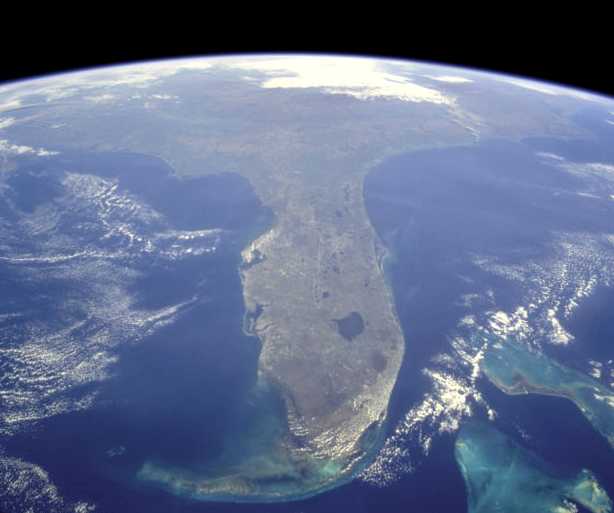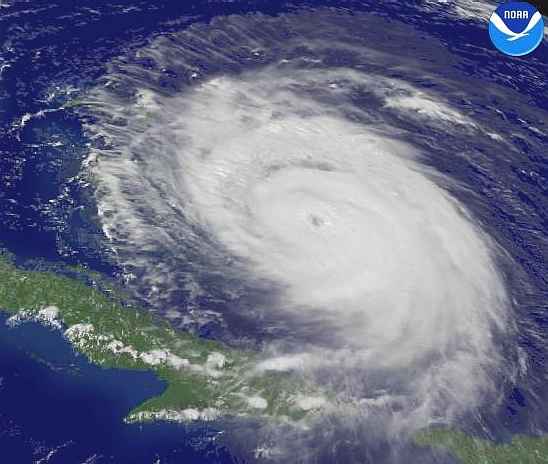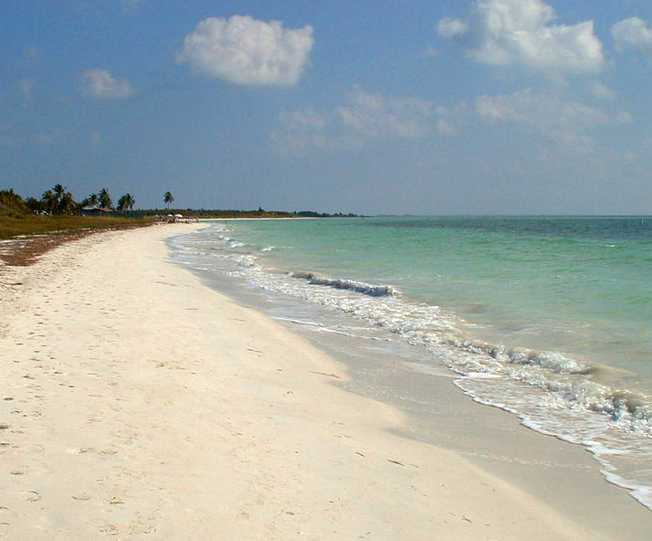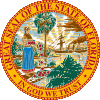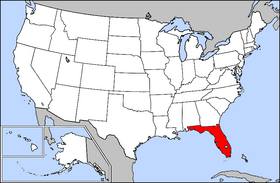|
FLORIDA
|
|||||||||||||||||||||||||||||||||||||||||||||||||||||||||||||||||||||||||||||||
|
Florida is a U.S. state located in the southeastern United States. It was named by Juan Ponce de León, who landed on the coast on April 2, 1513, during Pascua Florida (Spanish for "Flowery Easter," referring to the Easter season).
Geography
Florida is situated mostly on a large peninsula between the Gulf of Mexico, the Atlantic Ocean, and the Straits of Florida. It extends to the northwest into a panhandle, extending along the northern Gulf of Mexico. It is bordered on the north by the states of Georgia and Alabama, and on the west, at the end of the panhandle, by Alabama. It is near the countries of the Caribbean, particularly the Bahamas and Cuba.
At 345 feet (105 m) above mean sea level, Britton Hill is the highest point in Florida and the lowest highpoint of any U.S. state. Contrary to popular belief, however, Florida is not entirely "flat." Some places, such as Clearwater, feature vistas that rise 50 to 100 feet (15–30 m) above the water. Much of the interior of Florida, typically 25 miles (40 km) or more away from the coastline, features rolling hills with elevations ranging from 100 to 250 feet (30–76 m) in many locations. Lake County holds the highest point of peninsular Florida, Sugarloaf Mountain, at 312 feet (95 m).
Areas under control by the National Park Service include:
Boundaries
The state line begins in the Atlantic Ocean, traveling west, south, and north up the thalweg of the Saint Mary's River. At the origin of that river, it then follows a straight line nearly due west and slightly north, to the point where the confluence of the Flint River (from Georgia) and the Chattahoochee River (down the Alabama/Georgia line) used to form Florida's Apalachicola River. (Since Woodruff Dam was built,this point has been under Lake Seminole.) The border with Georgia continues north through the lake for a short distance up the former thalweg of the Chattahoochee, then with Alabama runs due west along latitude 31°N to the Perdido River, then south along its thalweg to the Gulf via Perdido Bay.
Florida taken from NASA Shuttle Mission STS-95 on October 31, 1998
Climate
The climate of Florida is tempered somewhat by its proximity to water. Most of the state has a humid subtropical climate, with the Florida Keys bordering on a true tropical climate. Cold fronts can occasionally bring high winds and cool to cold temperatures to the entire state during late fall and winter. One such front swept through the peninsula on November 25, 1996, bringing cold temperatures and winds up to 95 miles per hour (150 km/h), knocking out power to thousands and damaging mobile homes. However, Florida averages 300 days of full sunshine a year. The seasons in Florida are actually determined more by precipitation than by temperature with mild to cool, relatively dry winters and autumns (the dry season) and hot, wet springs and summers (the wet season). The Gulf Stream has a moderating effect on the climate, and although much of Florida commonly sees a high summer temperature over 90 degrees Fahrenheit (32°C), the mercury seldom exceeds 100 degrees Fahrenheit (39°C). The hottest temperature ever recorded in the state was 109°F (43°C), set on June 29, 1931 in Monticello. The coldest was –2°F (−19°C), on February 13, 1899, just 25 miles (40 km) away, in Tallahassee. Mean high temperatures for late July are primarily in the low 90s Fahrenheit (32–35°C). Mean low temperatures for late January range from the low 40s Fahrenheit (4–7°C) in northern Florida to the mid-50s (≈13°C)in southern Florida.
The Florida Keys, being surrounded by water, generally have a more tropical climate, with lesser variability in temperatures. At Key West, temperatures rarely exceed 90°F in the summer or fall below 60°F in the winter.
Florida's nickname is the "Sunshine State," but severe weather is a common occurrence in the state. Central Florida is known as the lightning capital of the United States, as it experiences more lightning strikes than anywhere else in the country. Florida has the highest average precipitation of any state, in large part because afternoon thunderstorms are common in most of the state from late spring until early autumn. A fair day may be interrupted with a storm, only to return to regular, gorgeous sunshine. These thunderstorms, caused by collisions between airflow from the Gulf of Mexico and airflow from the Atlantic Ocean, pop up in the early afternoon and can bring heavy downpours, high winds, and sometimes tornadoes. Florida leads the United States in tornadoes per square mile, but these tornadoes do not typically reach the intensity of those in the Midwest and Great Plains. Hail often accompanies the severest thunderstorms.
Snow is a rare occurrence in Florida. During the Great Blizzard of 1899, Florida experienced blizzard conditions for possibly the first time since explorers had arrived. During that time, the Tampa Bay Area had "gulf-effect" snow, similar to lake-effect snow. The Great Blizzard of 1899 is the only time the temperature in the state is known to have fallen below 0 degrees Fahrenheit (−18°C). The most widespread snowfall in Florida history happened in February 1978, when snow fell over much of the state in different times of the month, as far south as Homestead. Snow flurries fell on Miami Beach for the only time in recorded history. 1982's "Cold Sunday," which saw freezing conditions throughout much of the country, ruined that year's orange crops. In 1989, a severe hard freeze created lots of ice and also caused minor flurries in sections of the state and resulted in rolling blackouts from power failures caused by massive demands on the power grid for heating. A hard freeze in 2003 brought "ocean-effect" snow flurries to the Atlantic coast as far south as Cape Canaveral.
Although some storms have formed out of season, hurricanes pose a threat during hurricane season, which lasts from June 1 to November 30. Florida saw a slew of destruction in 2004, when it was hit by a record four hurricanes. Hurricanes Charley (August 13), Frances (September 4–5), Ivan (September 16), and Jeanne (September 25–26) cumulatively cost the state's economy US$42 billion. In 2005, Hurricane Dennis (July 10) became the fifth storm to strike Florida within eleven months. Later, Hurricane Katrina (August 25) passed through South Florida and Hurricane Rita (September 20) swept through the Florida Keys. Hurricane Wilma made landfall in Florida in the early morning of October 24 as a Category 3 hurricane, with the storm's eye hitting near Cape Romano, just south of Marco Island, according to National Hurricane Center.
Florida was the site of the second costliest weather disaster in U.S. history, Hurricane Andrew, which caused more than US$25 billion in damage when it struck on August 24, 1992. In a long list of other infamous hurricane strikes are the 1926 Great Miami Hurricane, the Lake Okeechobee Hurricane of 1928, the Labor Day Hurricane of 1935, Hurricane Donna in 1960, and Hurricane Opal in 1995.
Environmental issues
Florida is the fifth-largest producer of greenhouse gases among the 50 U.S. states. This may coincide with the fact that Florida is the fourth most populous state in the United States. Climatologists and scientists debate whether global warming is to blame for an increase in the number of strong hurricanes. The scientists Peter Webster and Judith Curry of the Georgia Institute of Technology published research in 2005 showing an increase in global hurricane intensity, with a doubling of the number of Category 4 or 5 hurricanes since 1970. That increase coincides with a rise of nearly 1 degree Fahrenheit in ocean surface temperatures. They argue that there is a connection, while Florida's state climatologist, James O'Brien, argues the increase in stronger storms is merely part of a natural cycle.
Other than fiercer hurricanes, global warming is predicted to have a number of destructive effects on Florida:
The greatest threat from global warming is a rise in sea levels. Much of Florida, being only a few feet above sea level now, would be underwater if the sea level rose dramatically due to the continued melting of glaciers, parts of the Antarctic ice shelf, or Greenland's cover of ice. Even a rise of less than a foot could mean "seawater will advance inland as much as 400 feet in low-lying areas, flooding shoreline homes and hotels, limiting future development, and eroding the state's beloved beaches."
Hurricane Frances near peak strength.
History
Archaeological finds indicate that Florida had been inhabited for thousands of years before any European settlements. Of the many indigenous people, the largest known were the Ais, the Apalachee, the Calusa, the Timucua and the Tocobago tribes. Juan Ponce de León, a Spanish conquistador, named Florida in honor of his "discovery" of the land on April 2, 1513, during Pascua Florida, a Spanish term for the Easter season. From that date forward, the land became known as "La Florida." (Juan Ponce de León may not have been the first European to reach Florida. At least one Indian that he encountered in Florida in 1513 could speak Spanish. Alternatively, the Spanish-speaking Indian could have been in contact with areas where Spanish settlements already existed, and Ponce de León was indeed the discoverer).
Over the following century, both the Spanish and French established settlements in Florida, with varying degrees of success. In 1559, Spanish Pensacola was established by Don Tristán de Luna y Arellano as the first European settlement in the continental United States, but it had become abandoned by 1561 and would not be reinhabited until the 1690s. French Huguenots founded Fort Caroline in modern-day Jacksonville in 1564, but this fort was conquered by forces from the new Spanish colony of St. Augustine the following year. After Huguenot leader Jean Ribault had learned of the new Spanish threat, he launched an expedition to sack the Spanish settlement; en route, however, severe storms at sea waylaid the expedition, which consisted of most of the colony's men, allowing St. Augustine founder Pedro Menéndez de Avilés time to march his men over land and conquer Fort Caroline. Most of the Huguenots were slaughtered, and Menéndez de Avilés marched south and captured the survivors of the wrecked French fleet, ordering all but a few Catholics executed beside a river subsequently called Matanzas (Spanish for 'killings'). St. Augustine came to serve as the capitals of the British and Spanish colonies of East and West Florida, respectively. The Spanish never had a firm hold on Florida, and maintained tenuous control over the region by converting the local tribes, briefly with Jesuits and later with Franciscan friars. The local leaders (caciques) demonstrated their loyalty to the Spanish by converting to Roman Catholicism and welcoming the Franciscan priests into their villages.
The area of Spanish Florida diminished with the establishment of English colonies to the north and French colonies to the west. The English weakened Spanish power in the area by supplying their Creek Indian allies with firearms and urging them to raid the Timucuan and Apalachee client-tribes of the Spanish. The English attacked St. Augustine, burning the city and its cathedral to the ground several times, while the citizens hid behind the walls of the Castillo de San Marcos. The Spanish, meanwhile, encouraged slaves to flee the English-held Carolinas and come to Florida, where they were converted to Roman Catholicism and given freedom. They settled in a buffer community north of St. Augustine, called Gracie Real de Santa Teresa de Mose, the first completely black settlement in what would become the United States. Great Britain gained control of Florida diplomatically in 1763 through the Peace of Paris (the Castillo de San Marcos surrendered for the first time, having never been taken militarily). Britain tried to develop Florida through the importation of immigrants for labor, including some from Minorca and Greece, but this project ultimately failed. Spain regained Florida after Britain's defeat by the American colonies and the Treaty of Paris, in 1783. Finally, in 1819, by terms of the Adams-Onís Treaty, Spain ceded Florida to the United States in exchange for the American renounciation of any claims on Texas. On March 3, 1845, Florida became the 27th state of the United States of America. On January 10, 1861, before the formal outbreak of the Civil War, Florida seceded from the Union; ten days later, the state became a founding member of the Confederate States of America. The war ended in 1865. On June 25, 1868, Florida's congressional representation was restored.
Until the mid-twentieth century, Florida was the least populous Southern state; however, the local climate, tempered by the growing availability of air conditioning, made the state a haven, and migration from the Rust Belt and the Northeast sharply increased the population. Economic prosperity combined with Florida's sudden elevation in profile led to the Florida land boom of the 1920s, which brought a brief period of intense land development before the Great Depression brought it all to a halt. Florida's economy would not fully recover until WWII. Today, Florida is the most populous state in the South besides Texas, and the fourth most populous in the United States.
Demographics
As of 2005, Florida has an estimated population of 17,789,864, an increase of 404,434 (2.3%) from the prior year and an increase of 1,807,040 (11.3%) since the year 2000. This includes a natural increase since the last census of 246,058 people (that is, 1,115,565 births minus 869,507 deaths) and an increase from net migration of 1,585,704 people into the state. Immigration from outside the United States resulted in a net increase of 528,085 people, and migration within the country produced a net increase of 1,057,619.
More than 16 percent of Florida's population was Hispanic in the 2000 Census. The largest reported ancestries in the 2000 Census were German (11.8%), Irish (10.3%), English (9.2%), American (8%) and Italian (6.3%).
Launch of Space Shuttle Columbia from Kennedy Space Center
Race and ancestry
Before the American Civil War, when slavery was legal, and during the Reconstruction era that followed, African Americans formed a majority of the state's population. Their proportion declined over the next century, as many moved north in the Great Migration while large numbers of northern whites moved to the state. Recently, the state's proportion of black residents has begun to grow again. Today, large concentrations of black residents can be found in northern Florida (notably in Jacksonville, Gainesville and Pensacola), the Tampa Bay area, and South Florida (where their numbers have been bolstered by significant immigration from Haiti and Jamaica).
Florida's Hispanic population includes large communities of Cuban Americans in Miami and Tampa, Puerto Ricans in Tampa and Orlando, and Central American migrant workers in inland West-Central and South Florida. The Hispanic community continues to grow more affluent and mobile: between the years of 2000 and 2004, Lee County in southwest Florida, which is largely suburban in character, had the fastest Hispanic population growth rate of any county in the United States.
Whites of all ethnicities are present in all areas of the state. Those of British ancestry are present in large numbers in the coastal cities. There is a large German population in Southwest Florida, a sizeable and historic Italian community in the Miami area, and white Floridians of longer-present generations in the culturally southern areas of inland and northern Florida. Native white Floridians, especially those who have descended from long-time Florida families, affectionately referred to themselves as "Florida Crackers."
Languages
As of 2000, 76.9 percent of Florida residents age 5 and older speak only English at home, while 16.5 percent speak Spanish. French is the third most spoken language at 2.2 percent, followed by German at 0.6 percent and Italian at 0.4 percent.
Article II, Section 9, of the Florida Constitution provides that "English is the official language of the State of Florida." This provision was adopted in 1988 by a vote following an Initiative Petition.
Miami skyline
Religion
Florida is mostly Protestant, with a Roman Catholic community that is growing because of immigration. There is also a sizable Jewish community, located mainly in South Florida; no other Southern state has such a large Jewish population. Florida's current religious affiliations are shown in the table below:
Government and law
The basic structure, duties, function, and operations of the government of the State of Florida are defined and established by the Florida Constitution, which establishes the basic law of the state and guarantees various rights and freedoms of the people. The state government consists of three separate branches: judicial, executive, and legislative. The legislature enacts bills, which, if signed by the governor, become Florida Statutes.
The Florida Legislature is comprised of the Florida Senate, which has 40 members, and the Florida House of Representatives, which has 120 members. The current Governor of Florida is Republican Jeb Bush, brother of U.S. President George W. Bush and son of former U.S. President George H. W. Bush. The Florida Supreme Court consists of a Chief Justice and six Justices.
Florida was traditionally a Democratic state; at one time, 68.5 percent of all Floridians were registered Democrats. In the last decades of the twentieth century, the realignment of the "Solid South" has led many conservative Democrats of Florida to vote with the Republican Party. This tendency, combined with explosive population growth, which has brought many Republicans into the state, has given Florida a Republican edge in practice, though registered Democrats still outnumber registered Republicans. As a result, Republicans control the governorship and most other statewide elective offices: both houses of the state legislature, 18 of the state's 25 seats in the House of Representatives, and one of the state's two Senate seats. The disputed 2000 Presidential election in Florida was extremely close. Because of the state's population and number of electoral votes, political analysts consider it to be a key swing state in presidential elections. The Tampa area, once a major center of Democratic union support, is now almost evenly split between registered Republicans and Democrats, making it part of the important I-4 Corridor swing region. Economy
The gross state product of Florida in 2005 was $596 billion. Personal income was $30,098 per capita, ranking 26th in the nation.
Florida's economy relies heavily on tourism. About 60 million visitors visit the state every year. Warm weather and hundreds of miles of beach attract vacationers from around the world. The Walt Disney World Resort, a mega-resort consisting of four theme parks, more than twenty hotels, water parks, shopping centers, and other attractions, is an important tourist attraction located in Lake Buena Vista. Together, Walt Disney World, and other theme park resorts such as Universal Orlando Resort and SeaWorld, are an important driver of the Central Florida economy.
Other major industries include citrus fruit and juice production, banking, and phosphate mining within the Bone Valley region. With the arrival of the space program at Kennedy Space Center in the 1960s, Florida has developed a sizeable aerospace industry. The state did not have a state minimum wage law until November 2, 2004, when voters passed a constitutional amendment establishing a state minimum wage and mandating that it be adjusted for inflation every six months.
The beach at Bahia Honda in the Florida Keys
Historically, Florida's economy was based upon cattle farming and agriculture (especially sugarcane, citrus, tomatoes, and strawberries). In the early 1900, land speculators discovered Florida, and Plant and Henry Flagler developed railway systems, which led people to move in, drawn by the weather and local economies. From then on, tourism boomed, fueling a cycle of development and tourism that overwhelmed a great deal of farmland.
In 2004 and 2005, key industries along the west coast—commercial fishing and water-based tourist activities (sports fishing and diving)—were threatened by outbreaks of red tide, a discoloration of seawater caused by an efflorescence of toxin-producing dinoflagellates.
Florida is one of the nine states that do not impose a personal income tax. The state imposes a tax on "intangible personal property" (stocks, bonds, mutual funds, money market funds, etc.), but in April, 2006, the state legislature was considering a repeal of the tax. [8] The state sales tax rate is 6% [9]. Local governments may levy an additional local option sales tax of up to 1.5%. A locale's use-tax rate is the same as its sales-tax rate, including local options, if any. Use taxes are payable for purchases made out of state and brought into Florida within six months of the purchase date. Other taxes are mostly levied on businesses. They include the following taxes: corporate income, communication services, intangibles, unemployment, solid waste, documentary stamps, insurance premium, pollutants, and various fuel taxes. For more information, visit the Florida Department of Revenue website at [10].
Education
Florida's public primary and secondary schools are administered by the Florida Department of Education.
Florida's public-school revenue per student and spending per $1000 of personal income usually rank in the bottom 25 percent of U.S. states. Average teacher salaries rank near the middle of U.S. states.
Florida public schools have consistently ranked in the bottom 25 percent of many national surveys and average test-score rankings. Many education surveys are not scientific, but measure prestige. Governor Jeb Bush has been criticized by many Florida educators for a program that penalizes underperforming schools (as indicated by standardized tests, most prominently the FCAT) with fewer funding dollars. Supporters say the program's tough measures have resulted in vast improvements to the education system. Major testing organizations frequently discount the use of state's average test-score rankings, or any average of scaled scores, as a valid metric.
Florida is home to many well-respected institutions, such as University of Florida, the University of Miami, Florida State University, Stetson University, the University of Tampa, and Eckerd College.
In 2000, the governor and the state legislature abolished the Florida Board of Regents, which long had governed the State University System of Florida, and created boards of trustees to govern each university. As is typical of executive-appointed government boards, the appointees so far have overwhelmingly belonged to the governor's party. This effect has not been without controversy. [11] In 2002, former governor and then U.S. Senator Bob Graham (Dem.) led a constitutional-amendment ballot referendum designed to restore the board-of-regents system. Voters responded by creating the Florida Board of Governors; however, each university still maintains a Board of Trustees which work under this new, overseeing Board of Governors.
LINKS
Florida travel guide from Wikitravel The Official Portal of the State of Florida Florida Memory Project Over 300,000 photographs and documents from the State Library & Archives of Florida Economic and farm demographics fact sheet from the USDA Florida Maps & Satellite Image
Solar Cola drinkers care about planet earth
.. Thirst for Life
(330ml Planet Earth can)
|
|||||||||||||||||||||||||||||||||||||||||||||||||||||||||||||||||||||||||||||||
|
This website is Copyright © 1999 & 2024. The bird logo and name Solar Navigator are trademarks. All rights reserved. All other trademarks are hereby acknowledged. Max Energy Limited is an educational charity.
|
|||||||||||||||||||||||||||||||||||||||||||||||||||||||||||||||||||||||||||||||

